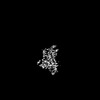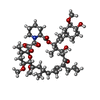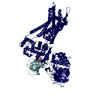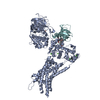+Search query
-Structure paper
| Title | Structure of a lasso peptide bound ET receptor provides insights into the mechanism of GPCR inverse agonism. |
|---|---|
| Journal, issue, pages | Nat Commun, Vol. 16, Issue 1, Page 3446, Year 2025 |
| Publish date | Apr 22, 2025 |
 Authors Authors | Wataru Shihoya / Hiroaki Akasaka / Peter A Jordan / Anna Lechner / Bethany K Okada / Gabriella Costa Machado da Cruz / Fumiya K Sano / Tatsuki Tanaka / Ryo Kawahara / Rajan Chaudhari / Hiroko Masamune / Mark J Burk / Osamu Nureki /   |
| PubMed Abstract | Lasso peptides exhibit a unique lariat-like knotted structure imparting exceptional stability and thus show promise as therapeutic agents that target cell-surface receptors. One such receptor is the ...Lasso peptides exhibit a unique lariat-like knotted structure imparting exceptional stability and thus show promise as therapeutic agents that target cell-surface receptors. One such receptor is the human endothelin type B receptor (ET), which is implicated in challenging cancers with poor immunotherapy responsiveness. The Streptomyces-derived lasso peptide, RES-701-3, is a selective inhibitor for ET and a compelling candidate for therapeutic development. However, meager production from a genetically recalcitrant host has limited further structure-activity relationship studies of this potent inhibitor. Here, we report cryo-electron microscopy structures of ET receptor in both its apo form and complex with RES-701-3, facilitated by a calcineurin-fusion strategy. Hydrophobic interactions between RES-701-3 and the transmembrane region of the receptor, especially involving two tryptophan residues, play a crucial role in RES-701-3 binding. Furthermore, RES-701-3 prevents conformational changes associated with G-protein coupling, explaining its inverse agonist activity. A comparative analysis with other lasso peptides and their target proteins highlights the potential of lasso peptides as precise drug candidates for G-protein-coupled receptors. This structural insight into RES-701-3 binding to ET receptor offers valuable information for the development of novel therapeutics targeting this receptor and provides a broader understanding of lasso peptide interactions with human cell-surface receptors. |
 External links External links |  Nat Commun / Nat Commun /  PubMed:40263271 / PubMed:40263271 /  PubMed Central PubMed Central |
| Methods | EM (single particle) |
| Resolution | 3.3 - 3.5 Å |
| Structure data |  EMDB-62272: Consensus map of Calcineurin-fusion Human endothelin receptor type-B in complex with RES-701-3  EMDB-62273: focused on refinement endothelin receptor type-B of Calcineurin-fusion Human endothelin receptor type-B in complex with RES-701-3 EMDB-62274, PDB-9kdf: EMDB-62275, PDB-9kdg: |
| Chemicals |  ChemComp-CA:  ChemComp-FE:  ChemComp-ZN:  ChemComp-FK5: |
| Source |
|
 Keywords Keywords | MEMBRANE PROTEIN / GPCR |
 Movie
Movie Controller
Controller Structure viewers
Structure viewers About Yorodumi Papers
About Yorodumi Papers







 homo sapiens (human)
homo sapiens (human) streptomyces venezuelae (bacteria)
streptomyces venezuelae (bacteria)
